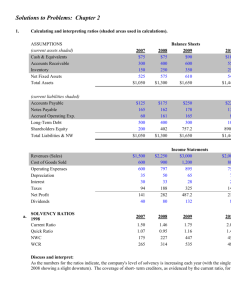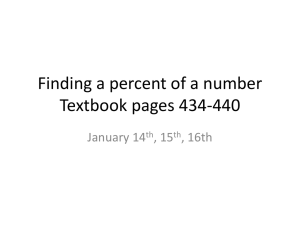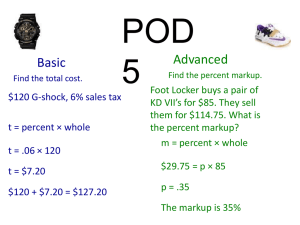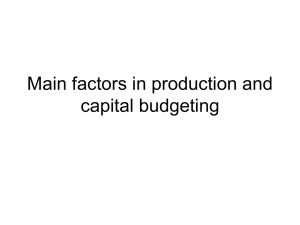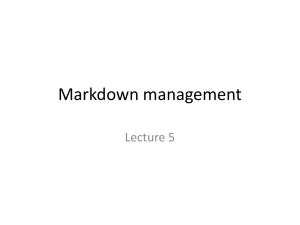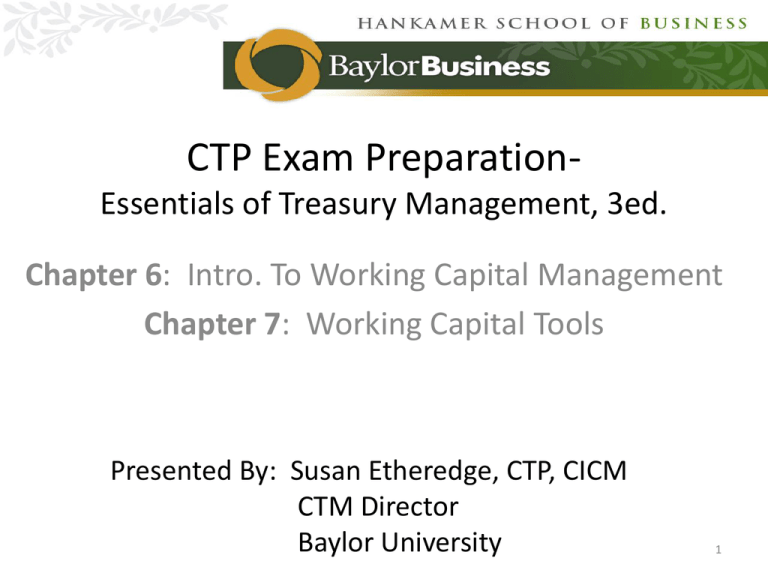
CTP Exam PreparationEssentials of Treasury Management, 3ed.
Chapter 6: Intro. To Working Capital Management
Chapter 7: Working Capital Tools
Presented By: Susan Etheredge, CTP, CICM
CTM Director
Baylor University
1
Chapter 6: Introduction to Working
Capital Management
Outline:
• The Cash Conversion Cycle (CCC)
• How Changes in Current Accounts Impact External
Financing
• Working Capital Investment and Financing
Strategies
• Management of Credit and A/R
• Management of Inventory
• Management of A/P
2
The Cash Conversion Cycle
Order
Received
<
Credit Sale
Inventory > <
(DIH)
$$$$
Received
Accounts Receivable
(DSO)
>
Time
<
Accounts Payable
(DPO)
Invoice Received
>
< CCC >
$$$$ Disbursed
Cash Conversion Cycle (CCC)
• Formula:
CCC = DIH + DSO – DPO
Days Inventory Held
Days
Receivables/Sales
Outstanding
Days Payables
Outstanding
Inventory
C ost of G oods Sold
365
Accounts R eceivable
365
R evenues
Accounts P ayable
C ost of G oods S old
365
Calculation of CCC and Cash Turnover
Calculate the CCC and Cash Turnover given the following:
• Days inventory = 45 days
• Days receivables = 35 days
• Days payables = 30 days
CCC = DIH + DSO + DPO
CCC = 45 + 35 – 30 = 50 days
Cash Turnover = 365/CCC = 365/50 = 7.3 times
5
Spontaneous Assets & Liabilities
Current Assets
Inventory and Accounts Receivable
As sales increase, inventory and A/R also increase, resulting in
larger dollar amounts invested in those accounts.
Increase results in decreased cash and/or increased debt
Current Liabilities
Accounts Payable and Accruals
A decrease results in decreased cash and/or increased debt
6
Current Asset Investment Strategies
• Restrictive
– Low levels of current assets relative to sales.
• Raw materials investment is tightly managed using JIT.
• A/R and cash balances are kept low.
– Result:
• Greater profit possible
• Greater risk
• Relaxed
– High levels of current assets relative to sales.
• High levels of cash
• High levels of A/R
– Result:
• Lower profit likely
• Less risk
7
Current Asset Financing Strategies
• Maturity Matching
• Conservative
• Aggressive
8
Credit Policies
Policies should clearly define:
• Credit standards
• Credit terms
• Discount terms
• Collection policies
Standards - Five C’s of Credit
Character
Willingness to pay -- evidenced by
payment history
Capacity
Current and future financial resources
that can be committed to pay obligations
Capital
Short- and long-term financial resources
-- supplement insufficient cash flow
Collateral
Assets or guarantees to secure an
obligation if non-payment
Conditions
Economic environment impacting
customer’s ability to pay, or willingness
of a company to grant credit
v3.0 © 2011 Association for Financial
Professionals. All rights reserved.
Forms of Credit Extension
Form
Payment
Due
Interest?
Customer
Type
Payment
restore
available
credit?
Open Account
(Open Book)
By invoice per
terms of sale
No – unless late
payment
B2B
Yes
Installment
Credit
Monthly –
equal
payments of
Prin. & Int.
Yes
B2C
No
Revolving
Credit
Monthly – on
unpaid
amounts plus
current month
purchases
Yes – on unpaid
balances
B2C
Yes
Both
Sometimes
(Like credit
cards)
Letter of
Credit – Int’l
Trade
May be sight or Sometimes
deferred
Common Terms of Sale
• Cash before delivery (CBD)
• Cash on delivery (COD)
• Cash terms
• Net terms
• Discount terms
• Monthly billing
• Draft/bill of lading
• Seasonal dating
• Consignment
12
Financing A/R
• Unsecured borrowing
• Secured borrowing
• Securitization
• Captive finance subsidiary
• Third-party financing
• B2B credit cards
• Factoring
• Private-label financing
13
Cross-Border Trade Management
Other methods:
• Banker’s acceptances (BAs)
• Trade acceptances
• Barter
• Countertrade
• Trading companies
Documentary Collection
Note: Banks act only as collecting and paying agents and do not guarantee payment
Foreign
Collecting
Bank
5-Pay
7-Pay
4-Docs
6-Docs
Buyer
(Importer)
Remitting
Bank
3-Docs 8-Pay
2-Ship
1-Agree
Seller
(Exporter)
v3.0 © 2011 Association for Financial
Professionals. All rights reserved.
Commercial vs. Standby L/Cs
Commercial
• Issued by a bank
• Payment mechanism
•
•
• Ensures payment for the
shipment of merchandise
•
• Typically requires
presentation of a draft,
commercial invoice and
shipping documents
•
Standby
Issued primarily by U.S. banks
“Stands by”-not intended as
payment mechanism
Ensures the performance of a
bank’s customer (applicant) to a
third-party (beneficiary)
Typically requires the
presentation of a sight draft and
notice of non-performance by
the applicant
L/C Transaction
3-Issue L/C
7-Docs
Issuing
Bank
8-B/A
11-B/A presented
2-Apply
for L/C
Advising/
Negotiating
Bank
6-Docs
10-Docs,
when pymt.
arranged
9-Pay
4-Advise
L/C
5-Ship
Buyer
(Importer)
1-Agree
Seller
(Exporter)
(Beneficiary)
v3.0 © 2011 Association for Financial
Professionals. All rights reserved.
Inventory Policy
• Reasons for holding
• Types held
• Levels of inventory
• Benefits and costs of holding
• Financing
18
JIT Inventory Management
•
•
•
•
Minimizes inventory
Often paired with MPS.
Retailers link to POS equipment.
Goals:
– Eliminate waste.
– Standardize the production process.
– Continuously improve quality.
• Benefits:
– Improved supplier relationships
– lower transaction costs
– better planning
• Supplier-managed replenishment programs
• Paid-on-production processes
19
A/P Responsibilities
• Vouchering
– Verify incoming invoices and authorize payments.
– Traditional three-way match: Invoice matched to
both an approved purchase order and receiving
information.
Invoice
• Disbursement System
– Information
– Fraud Prevention
– Relationship with Payees
P.O.
Goods
Rec’d.
20
Chapter 7: Working Capital Tools
Outline:
• Treasury Management Timelines
• Cash Discount Calculations
• Cash Conversion Cycle (CCC)
• A/R Monitoring and Control
• Considerations for Global
Management of Working Capital
• E-Commerce
Cash Flow Timeline and Float
v3.0 © 2011 Association for Financial
Professionals. All rights reserved.
Collection vs. Disbursement Float
• Mail float
• Processing float
• Clearing or Availability float (depends on POV)
Mail
Processing
Collection \ Availability POV of Payee
Disbursement \ Clearing POV of Payor
23
Float Neutral Calculation
Payment timing changes
Seller adjusts the timing (i.e., value
date) of the payment.
Price changes (discount
offer)
Seller offers buyer a cash discount
to compensate for earlier payment.
• Discount depends on buyer’s cost of funds and timing difference in days.
• Example: r = 12% and TD = 3 days.
D is c o u n t
= 1
Where:
TD = Total days
difference between check
and electronic payments
= 1
r = Opportunity cost
as an annual rate
=1
1
r
1
+
T
D
365
1
12%
1
+
3
365
1
= 1 0 .9 9 9 0 1 4 6 7
1 .0 0 0 9 8 6 3
= 0 .0 0 0 9 8 5 3 3 = 0 .0 0 1 (R o u n d e d ) o r 0 .1 0 %
v3.0 © 2011 Association for Financial
Professionals. All rights reserved.
Cost for a Buyer of Not Taking a Cash
Discount
• Terms: 2/10 net 30
• Should a discount be taken if the cost of shortterm funds is 8%?
Discount Cost =
D
365
100 D N T
=
2
365
100 2 30 10
=
2
365
= 0.0204 18.25 = .3723 or 37.23%
98
20
Where:
D = Discount percentage—2%
N = Net period—30 days
T = Discount period—10 days
v3.0 © 2011 Association for Financial
Professionals. All rights reserved.
Offering a Cash Discount: Benefit/Cost
for Seller
• Terms are 2/10, net 30.
• Seller’s opportunity cost of funds is 15%
• $100,000 sale
PVReceive on Day 10
TAFP 1 D $100,000 1 .02
=
=
= $97,598.91
CC
.15
1+T
1 + 10
365
365
PVReceive on Day 30 =
TAFP
1+
CC
N
365
=
$100,000
.15
1 + 30
365
= $98,782.13
NPV = PV Day 10 PVDay 30 = $97,598.91 $98,782.13 = $1,183.22
Where TAFP = total amount of full payment; CC = annual opportunity cost of capital (in this
example, 15%); D = discount rate; T = days in discount period; N = days in net period
v3.0 © 2011 Association for Financial
Professionals. All rights reserved.
Monitoring A/R
Monitoring individual accounts allows identification of:
– Errors or delays in the invoicing or payment that are slowing
collections
– Customers who may delay payment intentionally
– A change in financial condition that may alter a customer’s
ability to make timely payments and require the curtailment
of future credit sales
Monitoring aggregate A/R allows identification of:
– Changes in financing needs
– Changes in business
27
Days’ Sales Outstanding (DSO)
• Assume:
– outstanding receivables of $285,000 at the end of the first quarter
– credit sales of $310,000 for the quarter.
Using a 90-day averaging period, the DSO is computed as follows:
Avg. Daily Credit Sales =
DSO =
Sales During Period
Num ber of Days in Period
O utstanding A/R
Avg. Daily Credit Sales
=
=
$310,000
= $3, 444.4 4
90
$285,000.00
= 82.74 Days
$3, 444.44
If the company’s credit terms are net 60, the average past
due is computed as follows:
Average Past Due = DSO Avg. Days of Credit Term s
= 82.74 Days 60 Days = 22.74 Days
v3.0 © 2011 Association for Financial
Professionals. All rights reserved.
Aging Schedule
• Separates A/R into current and past-due
receivables in 30-day increments
• Can determine the percent past due
Age of A/R
Current
Amount of A/R
% of Total A/R
$1,750,000
70%
1-30 days past due
375,000
15%
31-60 days past due
250,000
10%
Over 60 days past due
125,000
5%
Total
$2,500,000
100%
v3.0 © 2011 Association for Financial
Professionals. All rights reserved.
A/R Balance Pattern for March
=+$ 25,000
=+$160,000
=+$105,000
=+$ 50,000
v3.0 © 2011 Association for Financial
Professionals. All rights reserved.
Multilateral Netting
31
Leading and Lagging
• Leading
– Paying before
– Payor’s currency is expected depreciate
• Lagging
– Paying after
– Payor’s currency is expected to appreciate
32
Re-Invoicing
v3.0 © 2011 Association for Financial
Professionals. All rights reserved.
Electronic Data Interchange (EDI)
Structured electronic transactions
Buy side
Sell side
Purchasing
Order placement
Receiving
A/P
Sales
Order processing
Shipping
A/R
Secure messages, no data reentry
Proprietary EDI
Exclusive use of trading partners
Retail, transportation, automotive
Cross-industry EDI
ASC X12
UN/EDIFACT
v3.0 © 2011 Association for Financial
Professionals. All rights reserved.
Use of the Internet for
E-Commerce and EDI
Internet-based e-commerce
Internet-enabled EDI
• Uses the Internet and Internet
technology to link business
applications between trading
partners
• Data transfer is often in a nonEDI format:
• Often used to encourage
smaller trading partners
to begin using EDI
• Useful for low
transaction volumes
within limited trading
communities
– Proprietary between two users
– Industry standard or a general
standard
35
Differentiate: ERS, P-o-P, EBPP, EIPP
• A manufacturer has a long CCC , a strategic
partnership with a single supplier, cannot adjust
raw materials turnover due to the nature of the
process, and must use JIT. Which e-commerce
process fits best?
a)
b)
c)
d)
Evaluated receipts settlement (ERS)
Paid-on-production
Electronic bill presentment and payment (EBPP)
Electronic invoice presentment and payment (EIPP)
36

